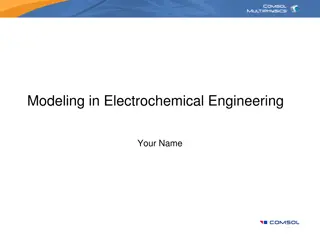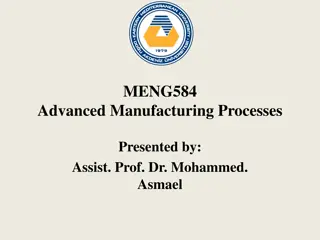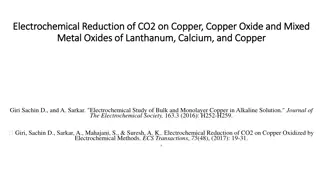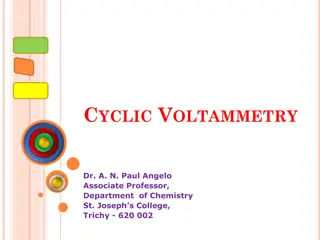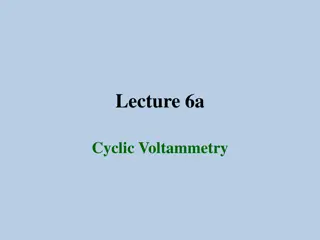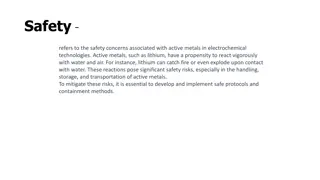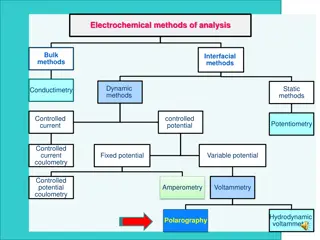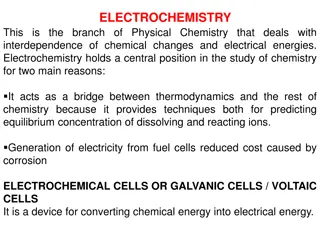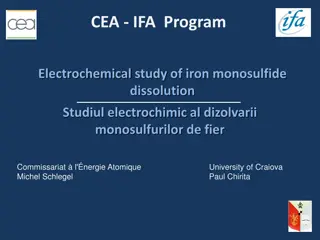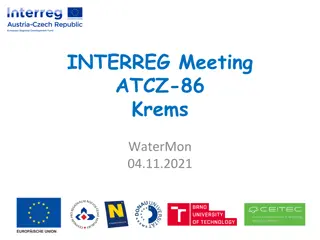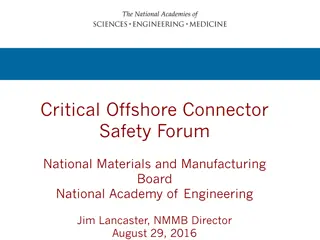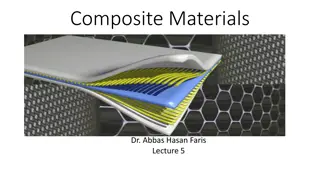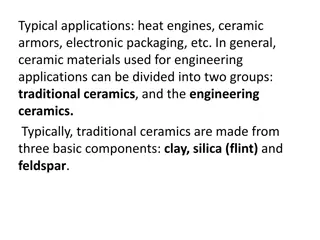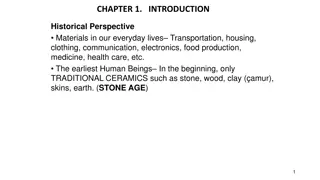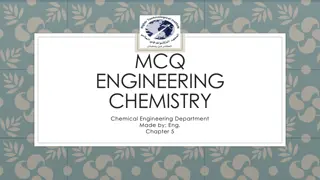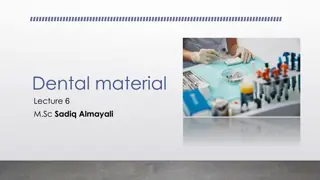Understanding Electrochemical Processes in Materials Engineering
Electrochemical processes play a crucial role in materials engineering, specifically in the context of corrosion. These processes involve both oxidation (anodic reaction) and reduction (cathodic reaction) reactions occurring simultaneously. Maintaining a balance between these reactions is essential to control the rate of corrosion. Various types of cathodic reactions can take place under different conditions, such as hydrogen evolution, oxygen reduction in acidic or neutral/basic mediums, metal ion reactions, and metal deposition. Examples illustrate how metals like zinc and iron undergo oxidation or corrosion reactions in different environments. Overall, electrochemical reactions must consist of at least one oxidation and one reduction reaction, with no net electrical charge accumulation.
Download Presentation

Please find below an Image/Link to download the presentation.
The content on the website is provided AS IS for your information and personal use only. It may not be sold, licensed, or shared on other websites without obtaining consent from the author. Download presentation by click this link. If you encounter any issues during the download, it is possible that the publisher has removed the file from their server.
E N D
Presentation Transcript
Materials Engineering Dr. Lubna Ghalib
Electrochemical process: There are two reactions taking place at the same time, a) Anodic reaction (Oxidation). b) Cathodic reaction (Reduction). 2Fe Fe2+ + 2e- O2 + 2H2O + 4e- 4(OH-) (Cathodic reaction) 2Fe + 3 2 O2 + 3H2O + 6e- 2Fe (OH)3 [ Rust ] Anodic and Cathodic reaction have to take place at the same rate otherwise the rate of corrosion would became slow. Normally the Cathodic reaction is the rate controlling process .There are various types of cathodic reactions possible under different conditions: M M2+ + 2e- anodic (Anodic reaction )
Electrochemical process: 1) Hydrogen evolution 2H+ + 2e- H2 (gas) Zn + 2HCl ZnCl2 + H2 Or Zn Zn2+ + 2e- (Anodic) 2H+ + 2e- H2 (Cathodic) 2) Oxygen reduction O2 + 4H+ + 4e- 2H2O [ in acidic medium with oxygen ] 3) Oxygen reduction O2 + 2H2O + 4e- 4(OH-) [ in neutral or basic medium ] This is the most kind reaction happens 4) Metal Ion reactions Fe3+ + e- Fe2+ M3+ + e- M2+ 5) Metal deposition M+ + e- M
Electrochemical process: An overall electrochemical reaction must consist of at least one oxidation and one reduction reaction, and will be the sum of them; often the individual oxidation and reduction reactions are termed half-reactions. There can be no net electrical charge accumulation from the electrons and ions; that is, the total rate of oxidation must equal the total rate of reduction, or all electrons generated through oxidation must be consumed by reduction.
Example 1: Zinc metal immersed in an acid solution containing H+
Example 1: Zinc will experience oxidation or corrosion according to, Zn Zn2+ + 2e- H+ ions are reduced according to, 2H+ + 2e- H2 (gas) The total electrochemical reaction Zn +2H+ Zn 2+ + H2 (gas)
Example 2: Oxidation or rusting of iron in water, which contains dissolved oxygen, this process occurs in two steps: Fe is oxidized to Fe2+ [as Fe(OH)2] Fe + 1 2 O2 + H2O Fe2+ to Fe3+ [as Fe(OH)3] 2 Fe(OH)2 + 1 Fe 2+ + 2OH- Fe(OH)2 2 O2+ H2O 2Fe(OH)3
Rate of corrosion : The most common methods used are 1 Weight loss in mg or gram. 2 % weight change. Poor sample shape and exposure Time influence results. 3 Milligram / sq. decimeter / day. ( mdd ). 4 Grams / sq. decimeter / day. 5 Grams / sq. centimeter / hour 6 Grams / sq. meter / hour. 7 Grams / sq. inch / hour. 8 Moles / sq. centimeter / hour.
Rate of Corrosion: Good but expressions do not give penetration rates. 9 - Inch / year. 10 - Inch / month. 11 mm / year most common method . Better expressions give penetration rates. 12 Mils per Year (MPY ) . mil = 1/ 1000 . Best expresses penetration without decimals or large numbers.
Rate of corrosion: ??? =534 ? ? ? ? Where W: weight loss in mg. D: density of metal in g/cm3 A: area of specimen in sq in. T: exposure time in hr.
Factors influencing corrosion rate : The rate and extent of corrosion, depends on the following factors: 1. Nature of the metal: Position in the galvanic series: The greater the oxidation potential, when the metal is higher up in the galvanic series, greater is its tendency to become anodic and hence greater is the rate of corrosion. Purity of metal: Lesser is the percentage purity of a metal, faster is the rate of corrosion. The impurities present in metal cause heterogeneity and thus tiny electrochemical cells are set up at the exposed part of the impurity and corrosion of metal around the impurity takes place due to local action.
Factors influencing corrosion rate : Physical state of the metal: The rate of corrosion is influenced by physical state of metal. The smaller the grain size of the metal or alloy, the greater will be its corrosion. Moreover, areas under stress, even in a pure metal, tend to be anodic and corrosion takes place at these areas. Nature of the oxide film: The ratio of the volumes of the metal oxide to the metal is known as "specific volume ratio". Greater the specific volume ratio, lesser is the oxidation corrosion rate.
Factors influencing corrosion rate : Relative areas of the anode and cathode: When two dissimilar metals or alloys are in contact, the corrosion of the anodic part is directly proportional to the ratio of the cathodic part and the anodic part. When cathodic area is smaller, the demand for electrons will be less and this result in the decreased rate of dissolution of metal at anodic regions. Solubility of corrosion products: In the electrochemical corrosion, if the corrosion product is soluble in corroding medium, then corrosion proceeds at a faster rate. For example, Pb in H2SO4 medium forms PbSO4 which is insoluble in the corroding medium, hence corrosion proceeds at a smaller rate.
Factors influencing corrosion rate : Volatility of corrosion products: Rapid and continuous corrosion of metal take place if corrosion product is volatile. This is due to the fact that as soon as corrosion product is formed, it volatilize, thereby leaving the underlying metal surface for further attack.
Factors influencing corrosion rate : 2. Nature of the corroding environment: Temperature: With increase of temperature of environment, the reaction as well as diffusion rate increase, thereby corrosion rate is generally enhanced. Humidity of air: The greater is humidity, the greater is the rate and extent of corrosion. This is due to the fact that moisture acts as a solvent for O2, H2S, SO2 and NaCI etc. to furnish the electrolyte essential for setting up a corrosion cell. Effect of pH: Corrosions of that metal which are readily attacked by acids can be reduced by increasing the pH of the attacking environment.
Factors influencing corrosion rate : Presence of impurities in atmosphere: Corrosion of metals is more in areas near to the industry and sea. This is due to the fact that corrosive gases like H2S, SO2, CO2 and fumes of H2SO4 and HCI in the industrial areas and NaCI of sea water leads to increased conductivity of the liquid layer in contact with the metal surface, thereby increase the corrosion rate. Presence of suspended particles in atmosphere: In case of atmospheric corrosion; (a) if the suspended particles are chemically active in nature [like NaCl, (NH4)2SO4], they absorb moisture and act as strong electrolytes, thereby causing enhanced corrosion; (b) if the suspended particles are chemically inactive in nature (e.g., charcoal), they absorb both sulphur gases, and moisture and slowly enhance corrosion rate.
Passivity: Passivity means the lack of activity under conditions where a metal would be expected to react readily. There are certain metals which are passive to certain corroding agents. For example; iron is passive to conc. HNO3. Aluminum has no action with conc. HNO3 in absence of chlorides etc. Metals which are susceptible to corrosion are made passive by alloying with one or more of metals which are passive or resist corrosion. For example; Iron is rendered passive by alloying it with any of the transition metals such as chromium, nickel and molybdenum.
Passivity : The quantity of passive metal to be added depends upon the environments. For example; iron-chromium alloy, when the quantity of chrome added is from 12 to 20%, the alloy is passive to neutral salt solution but no concentration of chromium in iron makes the alloy passive to hydrochloric acid. Passivity is definedas the reduction in chemical or electrochemical activity of a metal due to the reaction of metal with its environment so as to form a protective film on the metal surface.
Passivity : Corrosion rate of the a metal as a Function of solution oxidizing power (electrode potential) active metal (non-passive)
Passivity : Corrosion characteristics of an active-passive metal as function of solution oxidizing power
Passivity : There are three regions, Active, Passive & Transpassive Active region: the behavior of a normal metal. Passive region: If more oxidizing agent is added the corrosion rates suddenly decrease, this mean that this region begin. Transpassive region: with further increase in oxidizing agents the corrosion rate again increase with increasing oxidizer power.


